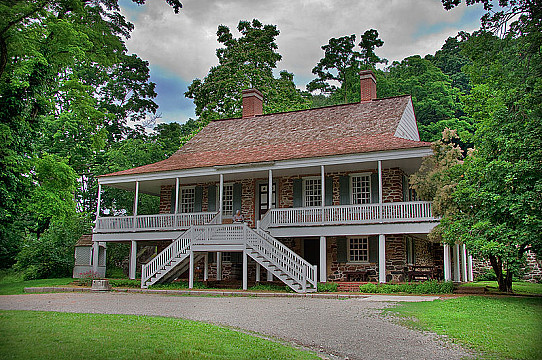Van Cortlandt Manor
South Riverside Avenue, Croton-on-Hudson, New York

This house is best associated with...
Philip died in 1746, leaving the manor house to his second son, Pierre Van Cortlandt, who moved in three years later (1749) with his wife, Joanna Livingston - first cousin of Robert Livingston (1708-1790), 3rd and last Lord of the Manor of Livingston. It was Pierre and Joanna who transformed the house into both a home and a working farm. They added the second story to the house and the porches. Nearby, they built barns, a carpenter's shop, a blacksmith's shop, a brick kiln, and laid out apple orchards.
War & Peace
During the Revolution, Pierre sided with the Patriot cause (unlike his nephew who built Cortlandt in England) and was a member of the Provincial Congress at White Plains that approved New York's Declaration of Independence in 1776. He later served as the 1st Lieutenant-Governor of the new State of New York and was frequently relied upon to step in as Acting Governor while George Clinton took to the battlefield. Pierre's eldest son, Philip, saw action as a Colonel and was a member of the court that tried Benedict Arnold.
During the war, Pierre moved with his family to what was referred to as the Upper Manor House at Peekskill, and then to Rhinebeck. In 1779, the vacated manor was raided by British troops. It was restored from 1783 and by 1803 Pierre and Joanna were once again living here full time. After Pierre died, it became home to his eldest son who had by then retired from politics and in 1824 joined the Marquis de Lafayette on his tour of the States.
Into the 20th Century and out of the Van Cortlandt Family
Philip died in 1831 leaving his share in the manor to his nephew, Philip Van Wyck, and in 1836 another of his nephews, Pierre Van Cortlandt III, moved in with his wife, Catharine Beck. Catharine outlived her husband and after her death in 1895 left the house in equal shares to her children. Their eldest daughter, Ann, never married and lived here until her death in 1940. Five years later, it was sold by Ann's nieces to Otis Chatfield Taylor who owned a local newspaper but died shortly afterwards (1948) in a car accident.
Decline and Rescue: Rockefeller's Sleepy Hollow Restorations
Taylor's heirs sold the property to Jerry Britchey, the owner the Croton's Starlite driving range and mini-golf. He replaced the old outbuildings with the Starlite Drive-in Theater (where ShopRite stands today). Sensing an impending inglorious end, John D. Rockefeller Jr. stepped in and bought the property, restoring both the house and the grounds which he then opened to the public in 1959. It was one of three houses (including Philipsburg Manor and Sunnyside) that Rockefeller rescued, restored and opened to the public. Collectively, they are known as the Sleepy Hollow Restorations. It remains open to the public today.
You May Also Like...
Categories
Styles
Share
Connections
There are 4 members connected to this house, are you? Connect to record your link to this house. or just to show you love it! Connect to Van Cortlandt Manor →
Alice Rees's ancestor, Col. Stephanus Van Cortlandt, owned Van Cortlandt Manor
Alice Rees's ancestor, Gertrude (Schuyler) Van Cortlandt, lived in Van Cortlandt Manor
Virginia Gobetz loves Van Cortlandt Manor
BenERubes loves Van Cortlandt Manor
William Ricketts's ancestor, Mary (Ricketts) Van Cortlandt, studies in Van Cortlandt Manor
William Ricketts's ancestor, Mary (Ricketts) Van Cortlandt, lives in Van Cortlandt Manor

















